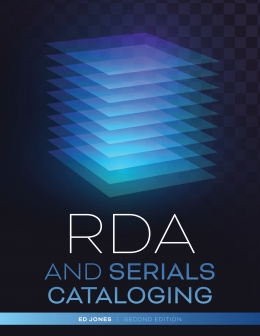
RDA and Serials Cataloging, Second Edition
This title will be available Fall 2024. You may place an order and the item will be shipped when it becomes available. For purchases outside the United States, please consult our International Orders page.
Primary tabs
You don't need to be an ALA Member to purchase from the ALA Store, but you'll be asked to create an online account/profile during the checkout to proceed. This Web Account is for both Members and non-Members.
If you are Tax-Exempt, please verify that your account is currently set up as exempt before placing your order, as our new fulfillment center will need current documentation. Learn how to verify here.
- Description
- About the author
- Reviews
Reflecting the new modelling for serials introduced by IFLA’s Library Reference Model in the most recent revisions to RDA, this up-to-date resource is an important tool for day-to-day practice as well as a reference manual for unusual or difficult cases.
Serials and continuing resources present a variety of unique challenges in bibliographic management, from special issues and unnumbered supplements to recording the changes that a long-running periodical can experience over time. Of this book’s first edition, the Australian Library Journal declared, “Highly recommended for any situation – technical service departments or library students – where serials need to be cataloged using RDA protocols.” Jones, a serials authority in the field and a major contributor to the 3R Project, here updates his authoritative text. Framing the practice within the structure of the IFLA LRM conceptual model on which RDA is now based, and its new modelling of serials, his guide
- introduces the concept of diachronic work and explains how serials, as a type of diachronic work, can be described using the new attribute element extension plan;
- explores new developments after the completion of the 3R Project, with references to AACR2 as a touchstone;
- introduces the new term work group and demonstrates its usefulness in enabling relationships and supporting collocation;
- demonstrates how serials catalogers' work fits in the cooperative context of OCLC, CONSER, and NACO; and
- presents examples of how RDA records can ultimately engage with the Semantic Web.
Ed Jones
Ed Jones has been cataloging serials, on and off, since 1976, and over the years has authored several scholarly papers and made numerous presentations on serials cataloging, the FRBR and FRAD conceptual models, and RDA. He has been a member of the CONSER Operations Committee, on and off, since 1981, and recently served as an RDA advisor. In 1995, he received his doctorate in library and information science from the University of Illinois at Urbana-Champaign. He is currently associate director for assessment and technical services at National University in San Diego.
Praise for the first edition
"A refreshing lack of tentativeness makes this a usable manual for hands-on practitioners. There is no ‘hemming and hawing' over matters where RDA is still a moving target and continuing to develop … Working catalogers will be able to use this manual for day-to-day practice and will find it of lasting value as a reference manual for unusual or difficult cases. It will be found useful in libraries large and small and can serve as a reassuring introduction to the cataloging of serial publications. Deft deployment of wry humor makes the book pleasantly readable."
— Collection Building
"Highly recommended for any situation – technical service departments or library students – where serials need to be catalogued using RDA protocols."
— Australian Library Journal


